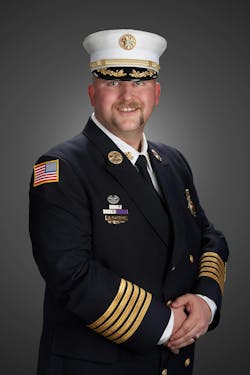Volunteer View: Alternative Funding Sources to Enhance Department Operations
The volunteer fire service doesn’t look the same everywhere in the United States. Budgets range from a few thousand to a few million dollars. For those departments that are on the lower end of the funding scale, ideas to help to bridge some budget gaps and enhance service delivery are explained below.
That said, unless you have philanthropic donors in your jurisdiction or found a mythical money tree, securing alternative funding is work. There’s no “easy” button. You must put in a lot of time and effort to research, plan and execute.
Research
Grants often are the first option that comes to mind, and they undoubtedly are a valuable tool.
National level grants that are available to departments include the FEMA Assistance to Firefighters Grant (AFG) Program; the Globe Gear Giveaway program that MSA Safety, DuPont Personal Protection and the National Volunteer Fire Council (NVFC) team up to provide; and the CHEMTREC Hazmat Emergencies Local Preparedness (HELP) Award that CHEMTREC and the NVFC sponsor.
Several foundations and companies also assist nationally, such as the Firehouse Subs Public Safety Foundation, the FM Global Fire Prevention Grant Program, the Gary Sinise Foundation, the Leary Firefighters Foundation and the State Farm Good Neighbor Citizenship grants.
At the state level, options vary. In Tennessee, for example, departments are fortunate to have the Volunteer Firefighter Equipment and Training Grant Program, the Rescue Squad Grant Program and Department of Agriculture Volunteer Fire Assistance program. There also is a program by which a regional electric company allows customers to round up the charge on their power bill to the nearest dollar and then administers grants with those funds to assist local community organizations.
State service organizations and a local chamber of commerce also might be able to assist a department.
Community partnerships often are overlooked. These partnerships can take on various forms. They can be as simple as a local business that provides discounted pricing of items to the fire department or as complex as donations of equipment and training. Recently, my department completed construction of an annex to the firehouse. The project was funded primarily through a Community Development Block Grant along with assistance from county and city government. The furnishings that are inside of the building were funded nearly completely via grants, donations and community partnership with local businesses.
Another department that’s located in my area partnered with a local facility that presents multiple rescue and hazmat challenges, to obtain funding for training and equipment.
These types of community partnership opportunities don’t just fall into your lap. You must establish relationships to make them happen.
Planning
After researching available funding sources, more detailed planning can begin. Once you identify specific opportunities that you wish to pursue, conduct a needs assessment of your department, prioritize those needs and determine their costs. Keep in mind that not every item that you want to fund is eligible to be funded by every source. Sometimes, a lower priority item might get funded first, because it’s eligible to be funded by a specific program, while others aren’t.
When it comes to grants, read the rules in detail. Know the limitations of funding amounts and eligible items. Keep in mind that there rarely is a one-stop shop for funding. My department’s special operations capabilities have improved greatly through grants and partnerships, but it has taken multiple years and numerous different grant programs.
Be flexible, creative and patient, because it might take multiple sources to achieve the long-term goal.
Don’t let your needs assessment turn into a wish list. Be able to justify everything that you request. AFG is a classic example of a circumstance in which you quickly can build a wish list—or what looks like a wish list to the evaluators—and before you know it, you don’t have enough narrative space to justify all of your items, and you end up with none.
In the case of community partnerships, be realistic in the requests that you make.
Execution
With research conducted and the plan built, it might seem as though the difficult work is done. No, it’s just the beginning. Now, you must write the grant, cultivate the relationships and have the conversations.
Depending on the grant, writing your proposal can be an intense process. If you aren’t a good writer, ask for help or find it through the plethora of grant writing classes that are available to access.
Typically, grant applications ask for detailed financial information in addition to the justification of the request. You should be maintaining your local data in a way that it’s easily accessible when it comes time to write a grant, because you will refer to the data, as well as the rules, many times in the process.
Just as you must do your homework for a grant application, you must do the same if you are going to sell a community partnership to another organization. Although it might be tempting to tug at heartstrings in a face-to-face meeting, be ready to justify your request with data and show a cost-benefit analysis, just as you would in the most difficult AFG application.
Be prepared for a rejection to a request or application. Of course, it’s disappointing to be turned down for something about which you are so passionate and that you worked so enthusiastically to develop. However, it’s part of the process, and the best way to handle the rejection is with dignity and grace. In the case of a community partnership, it simply might not be a good time for the request, and you don’t want to burn a bridge for the future.
Wrap up
Nothing about this process is easy. There is no magic path to success, no one-size-fits-all approach. Invest in the research and planning. It will pay off in the execution.
Reach out to departments that had success with different opportunities and learn from them. I’ve seen pride be a huge obstacle to success in many aspects of the fire service, and this area is no different.
Remember to place needs over wants and be realistic.
About the Author

Brandon Fletcher
Brandon Fletcher is the chief of the Gilt Edge Fire Department in West Tennessee and a 23-year student of the fire service. He is a second-generation firefighter who has a background as both a volunteer and career firefighter in the rural, suburban and airport/industrial settings. Fletcher holds a Bachelor of Science from the University of Tennessee at Martin and is a graduate of the Texas A&M Fire Service Chief Executive Officer program. He is a designated Chief Fire Officer and Chief Training Officer through the Center for Public Safety Excellence. Fletcher is a member of the Institution of Fire Engineers and NFPA's Fire Service Occupational Safety and Fire Officer Professional Qualifications technical committees. He is a hazmat specialist and serves as an instructor for the hazmat program at the Center for Domestic Preparedness in Anniston, AL.
